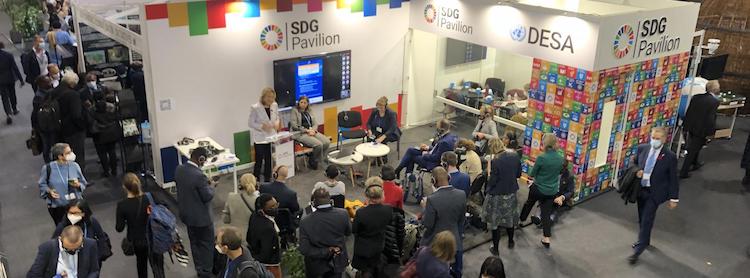By Thalif Deen
UNITED NATIONS (IDN) — When the two-weeklong COP27 climate summit began negotiations on November 6, the UN’s 17 Sustainable Development Goals (SDGs) were not far behind.
At the conference centre in the Egyptian coastal town of Sharm el-Sheikh, the UN’s Department of Economic and Social Affairs (DESA) is hosting an SDG Pavilion for interactive dialogues and discussions on key SDG thematic areas, particularly clean energy, water, forests, the ocean, and climate synergies—all of which will be on the forefront of the climate summit.
The Pavilion will be open until November 18 when the summit concludes.
During an interactive dialogue November 2 on the upcoming 2023 UN Water Conference, Csaba Kőrösi, President of the 77th session of the General Assembly said COP27 will be the first UNFCCC-COP that will feature water as a means of adaptation, as well as a lever for mitigation.
“We have also, in a consultation process with 1,200 stakeholders, been able to define the transformative game changers for the Conference and the process to follow.”
And it is reassuring to know that we have solutions for water scarcity, droughts, floods and wet heat bulbs.
The path, he said, which will continue with COP27 in Egypt and then COP28 in the United Arab Emirates (UAE) in November 2023, will be interlinked to the process of the UN 2023 Water Conference, the Sendai Mid Term Review, the SDG summit in September 23 and the Summit of the Future in 2024
The Sustainable Development Goals (SDGs), also known as the Global Goals, were adopted by the United Nations in 2015 as a universal call to action to end poverty, protect the planet, and ensure that by 2030 all people enjoy peace and prosperity.
The 17 SDGs are integrated—and recognize that action in one area will affect outcomes in others, and that development must balance social, economic and environmental sustainability.
Meanwhile, developing nations continue their relentless search for billions of dollars—now rising to trillions—to help achieve these targets by the year 2030.
But this appeal for funds—and not just commitments—has been virtually undermined by a shortage of funds triggered by rising inflation worldwide, sharp cuts in development aid by Western donors, the after-effects of the war in Ukraine and the devastation caused by the pandemic lockdown.
A new report released by the UN Development Programme (UNDP) on November 4 finds that countries are failing to make linkages to Sustainable Development Goals (SDGs) or gender equality in either short- or long-term climate plans—representing a significant missed opportunity.
Of those countries referencing just transition, currently only 6 and 4 countries link just transition to the Sustainable Development Goals in their Nationally Determined Contributions (NDCs) and Long-term Strategies (LTS) respectively, and only 10 and 7 refer to gender implications of a just transition in their NDCs and LTS respectively.
The report notes that the energy sector is receiving the most attention for a just transition. However, a comprehensive whole-of-economy, whole-of-society approach—one that addresses all sectors and secures buy-in from all quarters—is needed in order to bring have the greatest development gains.
Meanwhile, the 27th Conference of the State Parties to the United Nations Framework Convention on Climate—COP27—will build on the outcomes of COP26 (held in Scotland last year) to deliver action on an array of issues critical to tackling the climate emergency—from urgently reducing greenhouse gas emissions, building resilience and adapting to the inevitable impacts of climate change, to delivering on the commitments to finance climate action in developing countries.
Faced with a growing energy crisis, record greenhouse gas concentrations, and increasing extreme weather events, COP27 seeks renewed solidarity between countries, to deliver on the landmark Paris Agreement, for people and the planet.
With developing nations lagging far behind in achieving 17 SDGs, COP27 will focus largely on “Implementation”. But how far the summit will succeed is anybody’s guess.
According to the UN, 2022 is a critical year with regard to mitigation and adaptation action.
The outcomes of COP 26 signalled a shift from negotiations and setting targets to implementing actions and raising ambition further.
“Countries need to submit more ambitious short-term and long-term climate action plans to cut GHG emissions and enhance their resilience.”
The finalization of the IPCC Sixth Assessment Report in 2022 will be an important step in building the foundation for the work under the UNFCCC, including the global stock take.
The secretariat will be supporting work taking place to pave the way for a decision on the mitigation work programme at COP 27 and a strong political message from the ministerial high-level round table on ambition.
The secretariat will also be supporting work on achieving progress under the Glasgow–Sharm el-Sheikh work programme on the global goal on adaptation.
The global “stock take” will take stock of the implementation of the Paris Agreement by assessing collective progress towards achieving the purpose and long-term goals of the Agreement.
The secretariat says it supports the global stock take to ensure opportunities for effective participation and contribute to a common understanding of global efforts and priority actions to enhance national ambition and international cooperation. [IDN-InDepthNews – 06 November 2022]
Photo: SDG Pavilion. Credit: UN DESA


